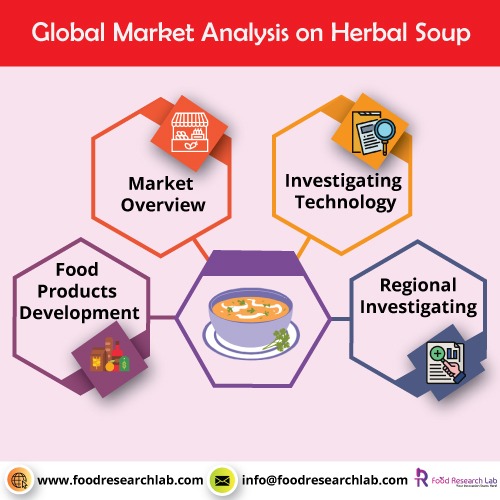In 2020, the global turnover in soups reached a volume of 2.8 billion dollars, an increase of 8% from 2019. Soup flows worldwide grew at a compound annual growth rate (CAGR) of +9.3% in dollars from 2001 to 2009 and +2.2 % from 2010 to 2019. In the scenarios 2021-2024, global soup trade is projected to develop at a CAGR of +7.2 % in dollars.
An overview of the herbal soup global market
In 2020, the global turnover in soups reached a volume of 2.8 billion dollars, an increase of 8% from 2019. Soup flows worldwide grew at a compound annual growth rate (CAGR) of +9.3% in dollars from 2001 to 2009 and +2.2 % from 2010 to 2019. In the scenarios 2021-2024, global soup trade is projected to develop at a CAGR of +7.2 % in dollars.
Market Overview
Soup is a spicy liquid that can be consumed as a whole meal. Soup is a nutrient-dense food that has several health advantages. Soups are high in vitamins, fats, and minerals since they contain ingredients such as green vegetables, beans, lentils, onions, mushrooms, beef, and rugged. Soup is one of the healthiest and easiest-to-digest foods because of the lighter and more complicated ingredients that make it up. Soups tend to increase immunity and avoid stomach infections when you’re sick. Many health-conscious individuals are transitioning to a soup diet, including replacing a whole meal with soup due to soup’s excellent and safe digestive properties. Soup sales are on the increase, thanks to the launch of new, imaginative, and exotic varieties by numerous soup manufacturers. The popularity of ready-to-eat raw soup has fueled a significant increase in the soup industry. Since most of the working population prefers processed foods and snack foods, the global supply and demand for soup are expected to increase. Since they provide limited servings for workplaces, colleges, take-out, and order-in, innovative and compact packaging for small-scale use has improved the soup industry. The majority of people choose fresh cooked meals or soups over frozen food and soups, citing the higher consistency and nutritional value of fresh food. This fact could put a damper on the canned soup industry. By the end of the forecast period, the global soup market will produce more than USD 19,655.9 million. By 2025, the global soups market is projected to develop at a CAGR of 3.07%. (1)
Investigating Technology
The soup market is growing and launching new, imaginative, and exotic varieties by numerous soup by new food product developers and food development companies. Since most of the working population prefers processed foods and snack foods, the global supply and demand for soup are expected to increase. Since they provide limited servings for workplaces, colleges, take-out, and order-in, innovative and compact packaging for small-scale use has improved the soup industry. Soup is a hot liquid that serves as a complete meal with green vegetables, beans, lentils, onions, mushrooms, beef, and hard soups. Soups are high in vitamins, nutrients, and minerals. Soup is considered one of the healthiest and easiest-to-digest meals because it has less powerful and complicated ingredients. Soups contain immunity-boosting resources that can also help avoid stomach infections if you’re ill. Many health-conscious individuals have switched to a soup diet because of its excellent and balanced digestion properties. The majority of people choose fresh cooked meals or soups over frozen food and soups, citing the higher consistency and nutritional value of fresh food. This fact could put a damper on the canned soup industry. Canned beverages usually contain preservatives, and their high sugar and salt levels pose a health risk to consumers.
Regional Investigating
Asia Pacific (China, Japan, Malaysia, Indonesia, Australia, The Philippines, India, Vietnam, Thailand, Singapore, South Korea, and the Rest of Asia Pacific), North America (the United States, Canada, and Mexico), Europe (the United Kingdom, Spain, Germany, Italy, France, and the Rest of Europe), the Middle East, Africa, Turkey, Egypt, GCC Countries, and South America) are the regions that make up the global market. (2)

- According to a survey compiled in 2017, North America is the world soup market’s market leader, accounting for 37.4% of the global soup industry. The North American economy in the soup industry has benefited from producers’ increasing interest in improving existing products and introducing new products in response to customer demand. (3)
2. Europe is expected to be the world’s second most important soup country, with a CAGR of 2.60% by the end of the projected period. The European soup market has grown by 40% thanks to increased public awareness about living a healthier lifestyle, transitioning to a soup diet from a full meal.
3. The Asia-Pacific soup market has been heavily influenced by rising demand for healthier food products development and regional enlargement of the soup market in countries with developing economies such as China, Japan, Singapore, and India.
4. Disposable income trends, innovative product releases, increased marketing efforts by industry manufacturers, and the emergence of new, foreign varieties have all proved to be driving the soup market in the rest of the world forward.
Recent Developments
- Clarity Food Ventures LLC launched Soup Explorers in 2020 to market a product in four distinct flavours that were simple to prepare and only took three minutes to prepare.
- Nestle India Limited recently purchased a 26% interest in Indocon Agro and Allied Activities Private Limited to increase their manufacturing market response to current customer demand.
- In 2016, Campbell Company launched ready-to-make soups with high nutritious content, including ingredients such as beef, vegetables, beans, and lentils.
Highlights
- In 2021, the Soups division will generate $50,112 million in revenue. The industry is forecast to rise by 0.71% each year (CAGR 2021-2025).
- In terms of global sales, Indonesia (US$8,025 million in 2021) generates the most.
- Taxes per resident of US$6.64 are produced in 2021, based on overall population estimates.
- By 2025, production in the Soups category is forecast to reach 11,274.8 Mkg. In 2022, the soups segment is forecast to rise by -2.4% in volume.
In 2021, the average volume per person in the Soups category is estimated to be 1.5 kilogrammes.

Let’s create something Innovative and Delicious together
Food Research Lab strives for excellence in new Food, Beverage and Nutraceutical Product Research and Development by offering cutting edge scientific analysis and expertise.




